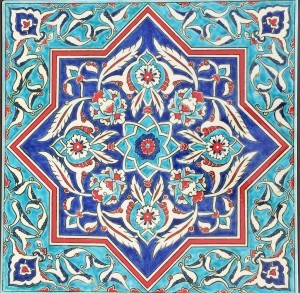
In the Ottoman period, tiles (çini) tied to architectural ornamentation ceramic was called "kâşî" and, the ceramics for general usage were called "evani". These two terms were not different in terms of their production and molding techniques but differed in the context of their usage.
Clay is the main material of the tile. The tile dough, which has been subjected to various operations, is dried after it is molded. Then it is cooked in the oven. On top of to be designed tiles, patterns which are drawn on transparent papers and pierced with needles are placed. After passing through the pattern with coal dust, the pattern is transferred onto the ceramic. The pattern whose contours are determined is then painted. The surface of the painted tile is glazed with a transparent glaze. The transparent glaze is produced by grinding the sülyen, which is produced from lead, with quartz and glass fractures, and by mixing with some wheat flour and water. After glazing, tile is put onto oven again.
Many techniques are used in the production of tiles and ceramics. The simplest tile technique is "unglazed ceramic". Ornamentation is applied in the imprint decoration, sgraffito and barbutin techniques, then, it is baked. The simplest glazed technique is glazed brick. After the brick is cooked, it is covered with a single-color glaze and re-fired. Techniques such as single-color glazed patternless tile, single-color glazed and gilded tile, tile mosaic, lüster, minai are examples of architectural tiles. As to the tiles made for usage, slip, sgraffito, lüster and minai techniques are seen. Lüster and minai are fallen into the sırüstü techniques; it is patterned twice and then fired. Sıraltı technique is the most common technique in ceramics and tiles as well. The patterns are applied to the tiles after they are shaped and undercoat. Then, it is lightly baked. Following this, it is glazed, and again fired.
In Ottoman architecture, tile was an important decorative element. The material of tile has changed over the course of the year and its quality has gradually increased. When the capital of the Early Ottoman Empire was Bursa, Konya gradually lost its position as being the center of the tile production. Between the 15th and 17th centuries, the main center was Iznik where the ceramist who were organized around guilds helped develop art of tile by applying various techniques. Between 15th and 18th centuries Iznik; then during the 16th and 18th centuries, the Tekfur Palace in Istanbul became important centers of tile.
Seven colors are seen in Iznik sıraltı tile and reddish specimens. The red color used in these tiles was in an elegant tone and in slight relief. In this period, the motif richness was also striking. The compositions were competent bodies composing of firstly herbal elements such as; realistic or stylized tulips, carnations, rosebuds, roses, violets, hyacinths, garnets, peonies, spring branches, apples and cypress, vines and grapes. Also, animal figures like birds, rabbits, fish etc. are seen in compositions of tile motifs as well as medallions, writing, marbling spots, çintemani and china clouds.
The best quality tile and ceramic samples of the Ottoman art are found in the "blue-white" group. This blue-white group was influenced by Far East Ming porcelain. Effected by Chinese influence, peony, chrysanthemum, arabesque, cloud, stamp, stylized dragon and three balls were the most common motifs used in this group. Herbal and figurative writing style were also seen. A distinctive group of ceramics with their spiral curved designs is examined in the blue-and-white group, which are rarely seen and mistakenly called "Golden Horn work" because of the similar sample previously found in Golden Horn.
There was an intensive production process from the first quarter of the 16th century to the end of the 17th century. Kütahya supported Iznik in case it failed to meet orders in this period. The tile ateliers developed by the demands of the palace assisted producing tiles for architectural and usage oriented products. The motif pool was flourished with the inclusion of galleons, sailboats, various animals, clouds and stylized figures. In terms of form, the most intense diversity was seen in this period.
Ceramic production accelerated in the city of Kütahya, which supported İznik before the end of the 18th century, after Iznik tiles and ceramics ceased to be manufactured. Elegant and nice ceramics were produced as being the high-quality products. Products such as small cups, envelopes, hokka, bowls, pitchers, goblets, flasks, censers, ornamental eggs, glasses, cups etc. were produced as examples of elegant tiles. Flowers, leaves, drops, ivy, birds, fish, human figures were seen on ceramics. They are impressive examples in terms of pattern and form. Low-quality samples were marked with lack of expensive colors such as red and purple, apply of rough patterns and reduced workmanship.
Çanakkale was also an important ceramic production center between the 18th and 20th centuries. The ceramics processed with the under-glaze (sıraltı) technique was characterized by their original forms and interesting designs. Later on, on-glaze (sırüstü) painting was also seen. Plates, bowls, cube, jug and pitcher are the most produced objects. The example of wall tile has not been found as yet. Examples of animal and human sculpture figures were also a seen frequently in the late period.
The art of pottery, which is made up of a raw mud, has been continuing in Anatolia since ancient times. Basic methods used in the construction of pottery by hand include çimdik, fitil, levha and model. Cups made up of concave sludge by hand or with use of pottery wheel are cooked in ovens. Among the objects that can be used with or without glaze are earthenware, pots, pitcher, vase and cube.
Today, important pottery centers include Eskişehir, Manisa, Bilecik, Nevşehir, Avanos, Adapazarı, Bursa, Balıkesir, Menemen, Kütahya, Konya and Diyarbakır.




